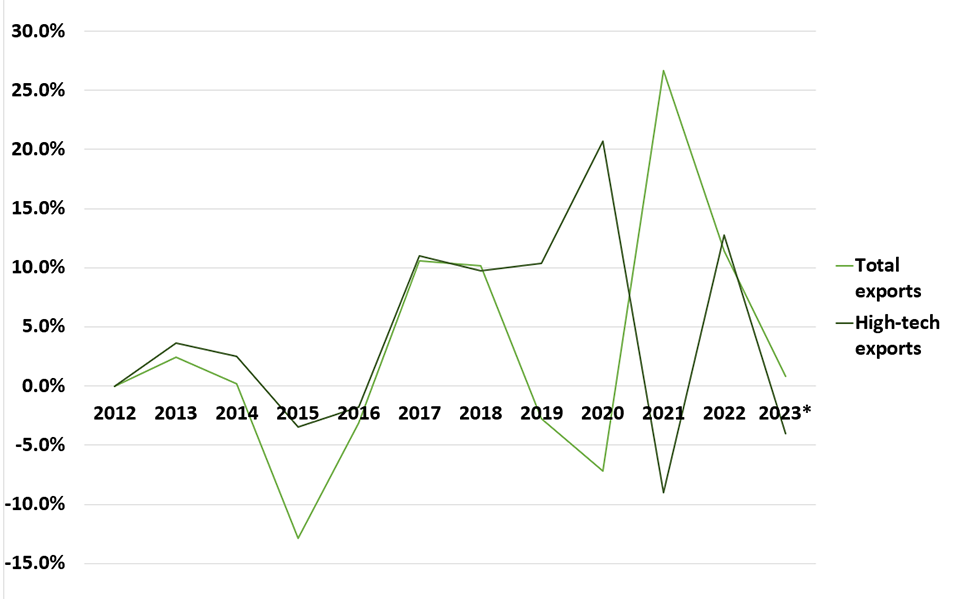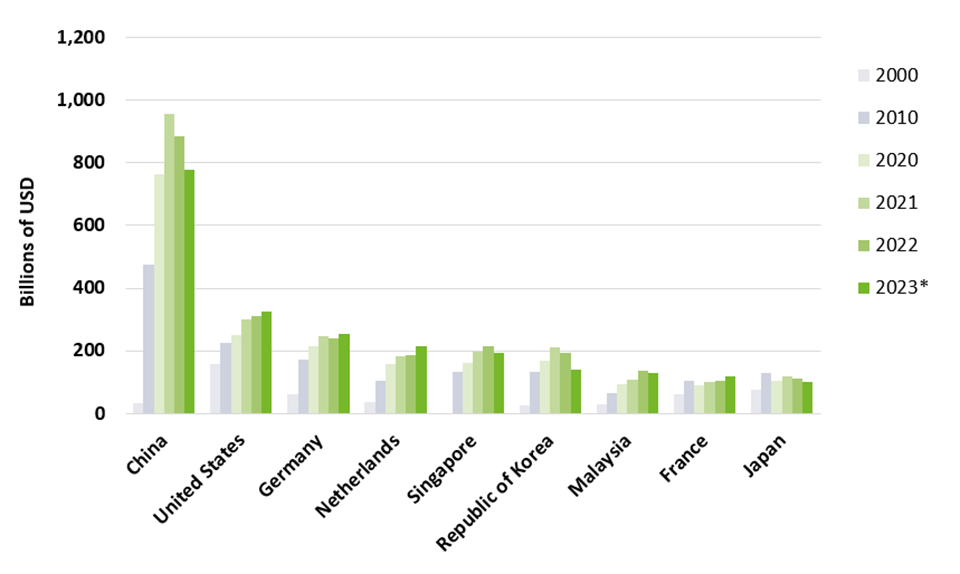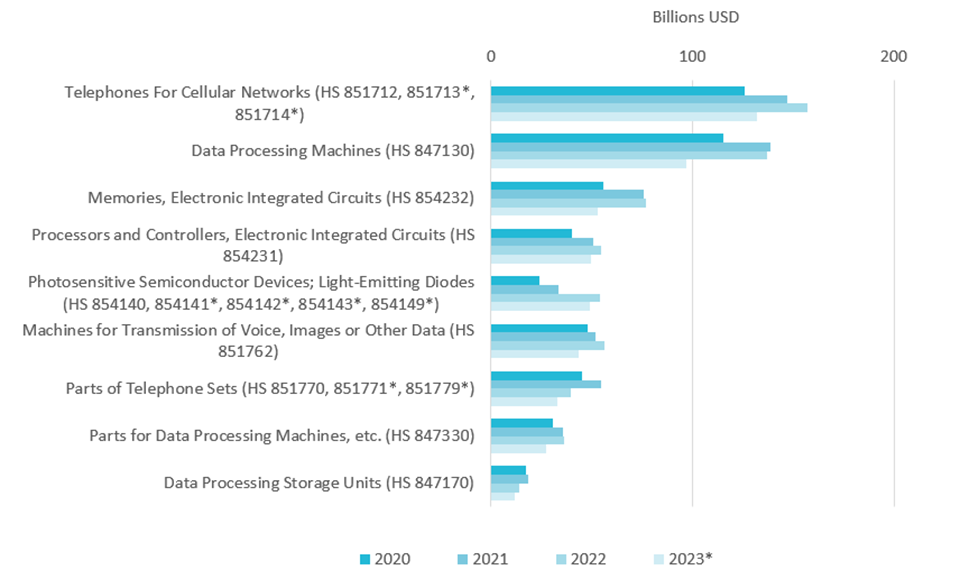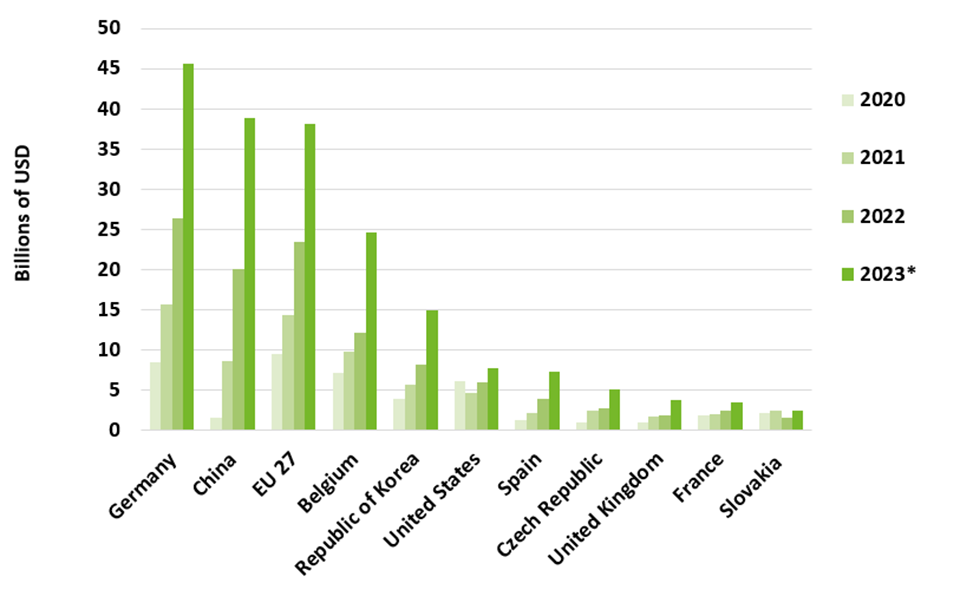High-Tech Trade Declines Amid Global Trade Slowdown and Reconfiguring Global Value Chains in 2023
January 25, 2024
By Lorena Rivera Léon, Anmol Kaur Grewal and Sacha Wunsch-Vincent, World Intellectual Property Organization (WIPO), and Don Brasher, Altan AE. Yurdakul, and John W. Miller, Trade Data Monitor (TDM)
China’s high-tech exports decline, while US and European exports are growing; India and Indonesia are among the fast-growing high-tech exporters. Exports of electric vehicles and medical technologies are booming.
It’s not an easy time for international trade.
Global and high-tech trade have soared and sunk like rollercoasters since 2019. After the strong post-pandemic recovery in 2021 followed by a slowdown in 2022, total merchandise trade is expected to grow at a meagre 0.8 percent in 2023, while high-tech exports are set to decline by 4 percent, according to an analysis by Trade Data Monitor and WIPO.
Changing global value chains and geopolitical tensions are driving some of the trade slowdown, as well as inflation which is increasing the costs of traded high-tech goods. The development of new sectors, particularly in the manufacturing of renewable energies, batteries and electric vehicles, helps mitigate the high-tech growth slump, however.
Figure 1
World Total Exports & High-Tech Exports
Annual Percent Change in USD Value
2012-2023*

Notes: *2023 projected based on current data
Chinese high-tech exports fell 11.4% to USD 728.2 billion in the first 10 months of 2023. The country’s smartphone exports fell by close to 7% to USD 106.8 billion, and sales of its data processing machines dropped 24% to USD 82.8 billion (see Figure 3). Shipments to many of China’s traditional trading partners dropped. Exports to the U.S. fell by 21% to USD 102.7 billion; to the Republic of Korea by 13.4% to USD 33.9 billion, and to the Netherlands by close to 20% to USD 33 billion.
Still, despite the decline, China is the leading high-tech exporter by far (see Figure 2).
Other Asian economies also experienced high-tech export declines. Exports of the Republic of Korea, for example, declined by 28% to USD 110 billion. Japanese exports fell 10% to USD 76.9 billion. Viet Nam’s export fared better, falling 1.7% to USD 115 billion in the first nine months of 2023.
By contrast, U.S. high-tech exports rose 4.4% to USD 282.5 billion. Shipments to Germany, the Netherlands and Belgium all rose by double digits. U.S. exports of smartphones, routers, board and panels, parts for gas turbines, and computers all increased.
Germany’s high-tech exports rose 6.6% to USD 217.4 billion over the first ten months of 2023. Exports of big airplanes rose 26.8% to USD 19.7 billion, shipments of immunological products rose 9.4% to USD 24.5 billion, and sales of processors and controllers, electric integrated circuits jumped 23.5% to USD 9.6 billion. And France’s high-tech exports increased 2.7% to USD 97.7 billion, thanks to increases in shipments of airplanes (up 16.9% to USD 19.7 billion), electronic integrated circuits (up 16.9% to USD 5.6 billion), and spacecraft, including satellites (up 438.4% to USD 2.1 billion).
Other fast-growing high-tech exporters in Europe include Austria, Hungary and Poland. Austria’s high-tech exports rose 16.9% to USD 22.1. billion in the first 10 months of 2023, thanks to hikes in shipments of anti-serum, up 26.7% to USD 3.8 billion, electrical panels, up 17.3% to USD 983 million, and transistors, up 40.8% to USD 650.1 million.
Hungary’s high-tech exports increased 10.8% to USD 20 billion, on the back of sales of processors, up 11.2% to USD 2.3 billion, routers, up 27% to USD 1.7 billion, and smartphones, up 99.7% to USD 1.1 billion. Polish high-tech shipments increased 7% to USD 29.5 billion thanks to sales of data processing machines, airplane parts and hearing aids.
Figure 2
Top High-Tech Exporters
Billions of USD
2000, 2010, 2020, 2021, 2022, 2023*

Notes: *2023 projected based on current data
Emerging high-tech exporters: India’s exports increased 16.5% to USD 33.7 billion over the first 10 months of 2023. India’s exports of smartphones rose 140.5% to USD 11.6 billion, while its shipments of turbojets increased 26.3% to USD 3 billion, and sales of solar panel cells rose 548.6% to USD 1.6 billion. Indonesian exports rose 3.6% to USD 8.7 billion, propelled by booms in the shipment of routers, up 56.3% to USD 1.8 billion, parts of automatic data processing, up 75.8% to USD 288 million, and smartphones, up 49.3% to USD 255.5 million.
Figure 3
China’s Top High-Tech Exports
Billions USD; 2020-2023**

Notes: * new subheading 2022, related to existing one ** 2023 projected based on current data
Medical technologies, electric vehicles, nuclear energy, and planes/spacecraft are booming
Medtech: The trade in Covid-19 tests and vaccines has continued to boom, but it is not the only medical export doing well. In the first 10 months of 2023, total sales of anti-serum and blood fraction by the world’s top 10 exporters increased 20.9% to USD 19.6 billion, and shipments of electro-diagnostic apparatus rose 15.9% to USD 11.2 billion. Exports of immunological products went up 13.6% to USD 61.8 billion. Shipments of hormones and steroids increased 12.8% to USD 12.1 billion. Exports of artificial joints and parts jumped 15.3% to USD 8.9 billion.
Electric vehicles: Innovations in batteries, steering and body design are boosting global trade in electric vehicles. As Figure 4 illustrates, Germany (up 86% in the first nine months of 2023 to USD 30.4 billion) and China (up 112% to USD 25.1 billion) are leading the charge, followed by Belgium (up 78.1% to USD 13.3 billion), the Republic of Korea (up 89% to USD 10.4 billion) and the U.S. (up 41.4% to USD 5.8 billion). Lithium oxides exports, used to make batteries, is up 80.1% to USD 5.2 billion.
Figure 4
Top Electric Cars Exporters: HS 870380
Billions of USD
2020, 2021, 2022, 2023*

Notes: *2023 projected based on current data
Exports of airplanes, spacecraft and goods to produce electric energy and nuclear reactors boomed too.
Background
The Global Innovation Index (GII) uses two indicators on high-tech trade (indicators 5.3.2 and 6.3.3) which are obtained through the United Nations Comtrade Database; the World Trade Organization, United Nations Conference on Trade and Development and Trade Data Monitor (TDM). Trade Data Monitor specializes in providing trade data for economic research. It obtains, processes, and publishes customs data from national governments around the world, for monthly publication.